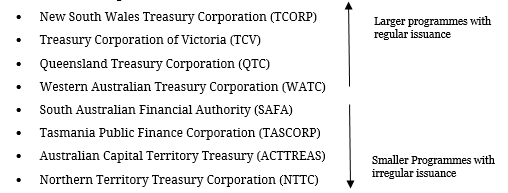Semi-Government Bonds (Semis) are issued by the central borrowing authorities of Australian state and territory governments. The central borrowing authorities have an explicit government guarantee from their parent state. Some of these securities also have a Commonwealth Government guarantee (made during the Global Financial Crisis). Issuance of Semi Government Bonds is primarily for budget funding and to support infrastructure investment in major utilities and transport entities. Semis are primarily fixed rate notes that pay semi-annual interest payments until maturity. However, some central borrowing authority also issue floating rate notes as well. These securities pay a quarterly interest payment equal to a fixed rate margin plus the appropriate benchmark floating rate Figure 1. Central Borrowing Authorities  Figure 2. Market Share of Semi-Government Bond Market
Figure 2. Market Share of Semi-Government Bond Market  The securities are released to the public via dealer panels. Each borrowing authority has their own panel of banks known as a dealer panel to support liquidity of their liabilities (semis). These institutions make prices to the market and distribute to the domestic market. The bulk of state government are known as benchmark bonds. Under these securities, the issuing state treasury corporation commits to maintaining a minimum amount outstanding in the specified bond at any given time. These bonds also allow the borrowing authority to tap the existing line for additional funds instead of pursuing additional new bond issuance. As state governments do have the ability to print money, they have a marginally higher element of default risk than the Commonwealth of Australia. For this reason, semi government bonds typically have higher yields that their government bond counterparts to compensate for this incremental credit risk.
The securities are released to the public via dealer panels. Each borrowing authority has their own panel of banks known as a dealer panel to support liquidity of their liabilities (semis). These institutions make prices to the market and distribute to the domestic market. The bulk of state government are known as benchmark bonds. Under these securities, the issuing state treasury corporation commits to maintaining a minimum amount outstanding in the specified bond at any given time. These bonds also allow the borrowing authority to tap the existing line for additional funds instead of pursuing additional new bond issuance. As state governments do have the ability to print money, they have a marginally higher element of default risk than the Commonwealth of Australia. For this reason, semi government bonds typically have higher yields that their government bond counterparts to compensate for this incremental credit risk.

